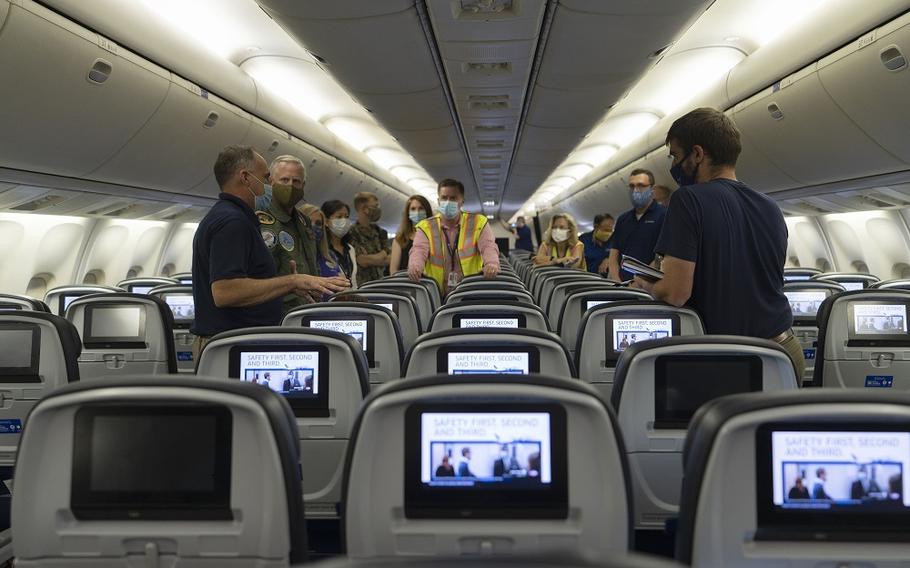
David Silcott, chief executive of S3i, a biological research company, discusses airflow particle testing on board a United Airlines 767 aircraft at Dulles International Airport, Va., on Aug. 28, 2020. The test data released Thursday shows the possible spread of the coronavirus among passengers is low and could help determine future processes for loading and quarantining passengers. (Stephenie Wade/TRANSCOM)
Stars and Stripes is making stories on the coronavirus pandemic available free of charge. See other free reports here. Sign up for our daily coronavirus newsletter here. Please support our journalism with a subscription.
AUSTIN, Texas — The risk of catching coronavirus through the air aboard a crowded commercial airplane from an infected passenger who is wearing a mask is very low, according to a new Defense Department study on the safety of air travel during the pandemic.
The Commercial Aircraft Cabin Aerosol Dispersion Test conducted by U.S. Transportation Command, or TRANSCOM, found 99.99% of particles released into the air from an infected person wearing a mask were removed from an airplane cabin within six minutes of being released, according to the study, which was released Thursday. It takes about 90 minutes to clear the particles in the average home.
“Within the scope of the test, the analysis showed overall low exposure risk on these aircraft from airborne pathogens like [coronavirus],” Vice Adm. Dee Mewbourne, deputy commander for TRANSCOM, said during a briefing with reporters. “We invested in the aerosol particles study to better inform us how to complete the mission of transporting our passengers within this pandemic environment while maximizing their safety.”
Conducted aboard Boeing 767 and 777 jets, which are part of United Airlines fleet, the “favorable results” stemmed from the combination of the planes’ high air-exchange rates, the air filtration and recirculation system and the downward airflow ventilation design, Mewbourne said, speaking alongside scientists who conducted the six-month study. These aircraft were chosen because they are often the model of plane contracted by the military to conduct Patriot Express flights between bases.
The study was conducted during an eight-day period in August at Dulles International Airport in Virginia and cost about $1 million. Boeing provided engineers to answer questions about the aircraft, and United Airlines provided the flight time at no cost to the government.
Mannequins were placed in various locations on the plane to measure aerosols released from breathing and coughing with and without surgical masks. More than 300 aerosol releases were performed and involved inflight, simulated inflight and on-the-ground testing.
“We found that on cough stimulations [with the mask], there was a very large reduction in aerosol that would come from the mannequin — greater than 95% in most cases. It greatly showed the benefit of wearing a mask during a flight for these tests,” said David Silcott, an author of the study from S3i, a biological research company.
The 53-page report of the study will be reformatted for journal entry submissions and peer review. The researchers involved see the study as a launchpad for further research on the subject because it did not include variables such as multiple infected passengers, large projectile droplets containing the virus and movement in the cabin, such as the infected passenger getting up to use the restroom or even turning their head to speak.
“From the commercial travel perspective what this study provides you is a foundational set of data the commercial aircraft industry can utilize for modeling applications,” said Eric Van Gieson, program manager at Defense Advanced Research Projects Agency.
Through modeling, other researchers can use this study to explore scenarios not addressed by TRANSCOM with “a deeper understanding of air movement in the aircraft,” he said.
TRANSCOM will now take the results of the study to review how service members and their families move through air travel and potentially revise current policies.
While the results show a policy requiring all passengers to wear masks through flights is the right choice, perhaps the military can revisit a policy to cap flights at 80% to 90% capacity, Mewbourne said.
The command also will review how the study can impact contact tracing and postflight quarantines should an infected passenger be identified from a flight.
In the study, released droplets reduced by 99% by the time they reached the next passenger’s seat and became immeasurable a few seats farther, Mewbourne said.
“We’re very encouraged by the results, and that’s part of reason we’re making it public and sharing with the scientific community so that follow-on research can be done,” said Navy Cmdr. Joe Pope, operations analysis and assessments branch chief within TRANSCOM. “Technically speaking, the results are good for these two aircraft in the conditions tested.”
Thayer.rose@stripes.com Twitter: @Rose_Lori